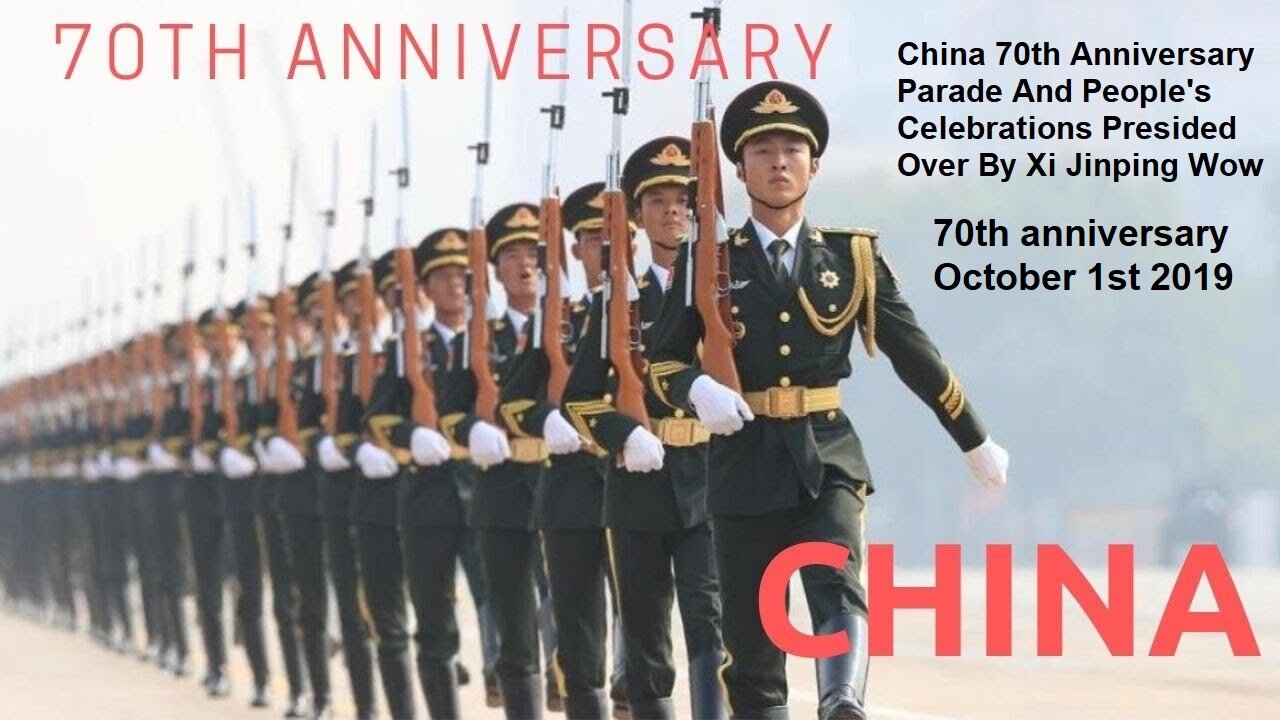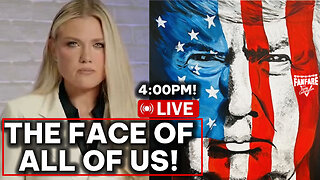Premium Only Content

China 70th Anniversary Parade And People's Celebrations Presided Over By Xi Jinping
China is celebrating its 70th anniversary on October 1st 2019 with a large military parade featuring 100,000 performers led by Prime Minister Xi Jinping. Along the way, there will be fireworks, fanfare and pigeon lockdowns to mark the occasion. Troops in military vehicles take part in the military parade and Chinese peacekeeping troops march past Tiananmen Square. https://www.dailymail.co.uk/news/article-7523145/Chinas-70-year-parade-economic-military-might.html - No force can shake this great nation': President Xi leads spectacular ceremony to mark 70 years of Communist rule in China and unveils top-secret hypersonic DF-17 missile for the first time. China held a huge parade to mark the 70th anniversary of the founding of the People's Republic on Tuesday. Military display, featuring 15,000 troops, 160 aircraft and 580 pieces of equipment, was the first since 2015. Beijing used it as an opportunity to show off its new technology - including the Dongfeng 41 ICBM, which it claims can hit anywhere in the US within 30 minutes, and the DF-17 hypersonic missile. Military show followed by civilian parade involving 100,000 people and showcasing China's economic might 2019
China showed off its military power and economic prowess during a parade to mark the 70th anniversary of the founding of the People's Republic on Tuesday.
The display was presided over by Xi Jinping, wearing a grey jacket in echoes of Mao Zedong. Standing in an open-topped car, he watched the show from the Gate of Heavenly Peace, from where Mao proclaimed the founding of the modern nation in 1949.
The military parade was China's first large-scale display of arms since 2015 and was used to showcase the leaps that its army - which has the second-largest budget in the world behind the US - has made since then.
Included in the display was a new intercontinental ballistic missile capable of hitting anywhere in America within 30 minutes, a hypersonic nuclear missile that is theoretically capable of evading all known missile defence systems, along with new stealth drones and aircraft.
The military showcase was then followed by a civilian parade celebrating the country's economic development that has seen it rise become a world superpower.
'No force can ever shake the status of China, or stop the Chinese people and nation from marching forward,' Xi said as he inspected rows of vehicles, troops and gleaming missiles.
China used the parade to unveil a wealth of newly-developed technology, including the Dongfeng 41 intercontinental ballistic missile (pictured) which is believed to be one of the most powerful nuclear weapons on the planet. It has a range of almost 9,500 miles and could theoretically strike anywhere in the US within 30 minutes using 10 nuclear warheads
Also unveiled during the parade was the Dongfeng 17 hypersonic missile, an intercontinental-rage weapon which releases its warhead in low-earth orbit. The warhead then travels at hypersonic speeds to its target and is capable of changing target mid-air, which Beijing claims makes it impossible to counter. Washington believes it can also be tipped with a nuclear warhead
China also showed off its new drone technology, including this - the W-8 hypersonic reconnaissance drone. The drone's sleek body and high speed is designed to evade radar systems. The craft itself would be used to acquire targets for China's new missiles, including its anti-aircraft carrier weapons
Xi Jinping, wearing a grey jacket in echoes of modern China's founding father Mao Zedong, watches the parade from the Gate of Heavenly Peace, where Mao proclaimed the founding of the People's Republic of China 70 years before
Another never-before-seen weapon on display was the JL-2 submarine-launched intercontinental ballistic missile. The weapon has an estimated range of 5,600 miles and is capable of delivering nuclear warheads, though exactly how many remains unclear
Unveiled for the first time at the parade was the Dongfeng-100 intermediate range missile, a hypersonic weapon that is designed to be used against large warships. It is the development of weapons such as this that caused America to back out of the Intermediate Range Nuclear Forces treaty with Russia, saying it needed to be able to combat them with missiles of its own
Another new piece of kit on display in Beijing was the GJ-11 long-range stealth attack drone, which is based on the American-made B-2 strategic bomber, and is designed to strike targets deep in enemy territory without being detected. China says all of the technology on display Tuesday is already in active service
Soldiers of the People's Liberation Army stand at attention in the top hatch of armoured vehicles, armed with what appear to be W85 mounted machine guns during a parade to mark the 70th anniversary of the Communist Party
China put on an intimidating show of strength on Tuesday as it held a huge military parade in Beijing to mark the 70th anniversary of the founding of the Communist Party. Pictured are Chinese infantry fighting vehicles
China has the second-highest military budget in the world, behind only the USA, and it has been growing at 10 per cent every year for the last decade. Pictured are Chinese troops on parade holding what appears to be a QBZ-03 assault rifle, though could be a new design after rumours began circulating last year that it was replacing the two-decade-old weapon
A large part of China's military budget goes towards maintaining the largest standing army in the world, with over 2million men and women in uniform. Pictured are soldiers of the People's Liberation Army holding bullpup QBZ-95 rifles while marching through the streets of Beijing during a rehearsal
Chinese troops march past Tiananmen Square during a military parade marking the 70th anniversary of the founding of the People's Republic of China in Beijing
Chinese naval troops - just some of the 15,000 servicemen and women who took part in the parade - march in front of banners proclaiming the 70th anniversary of the founding of the Chinese Communist Party
China special forces line up in formation in front of HQ-9B missiles - a homing weapon similar to the Russian S-300 and American Patriot systems which are designed to shoot down incoming warheads. The troops appear to be armed with CS/LR17 rifles, which were first unveiled in 2016
A formation of the People's Liberation Army Navy takes part in a military parade during the celebrations marking the 70th anniversary of the founding of the People's Republic of China
Troops march through Tiananmen Square underneath a giant display reading 1949, the year that modern China was established along with the Communist Party under Mao Zedong
Donald Trump sent his congratulations to Xi following the parade, and congratulated the Chinese people on establishing their Communist Republic
The centrepiece of the military display was the formidable new Dongfeng 41 intercontinental ballistic missile, which is believed to be one of the most powerful nuclear weapons on the planet.
Analysts believe the missile is capable of ranging anywhere in the US and can hit targets within just 30 minutes of being fired with 10 nuclear warheads that are capable of striking multiple targets simultaneously.
Also unveiled for the first time was the Dongfeng-17, a hypersonic nuclear missile that is also though to carry multiple warheads, fly faster than conventional weapons to evade defence systems, and at a lower altitude to avoid detection before impact.
The nationally televised event opened with a military honor guard carrying the Chinese flag through Tiananmen Square, the country's symbolic political heart, before thousands of spectators who waved flags. Artillery guns fired a salute.
President Xi and other Chinese leaders, including former Presidents Hu Jintao and Jiang Zemin, watched from atop the Gate of Heavenly Peace at the square's north end.
The event marks the anniversary of the Oct. 1, 1949, announcement of the founding of the People's Republic of China by then-leader Mao Zedong following a civil war.
The parade follows Xi's promise to allow Hong Kong to manage its own affairs despite anti-government protests that have embarrassed the ruling party ahead of the year's highest-profile propaganda event.
The parade through central Beijing is due to include 15,000 troops and more than 160 aircraft.
China has unveiled a bristling array of new military technology during a parade to mark the founding of the Communist nation 70 years ago. The hardware included...
Missiles - DF-41
China's latest intercontinental ballistic missile (ICBM) which is said to be capable of ranging up to 9,300 miles - putting the entirety of America within its reach.
The missile is said to carry up to 10 nuclear warheads which can be independently manoeuvred, meaning it can strike 10 targets simultaneously.
In order to evade defence systems it also carries decoys and can hit the US within 30 minutes of launch, limiting the amount of time defence systems have to respond.
DF-17
Another intecontinental ballistic missile, this one is fitted with a warhead that can travel at hypersonic speeds (see the flared nose-cone, above).
The warhead is also designed to fly lower than traditional ICBMs, making it much harder for radar defence systems to detect before it strikes.
China claims the weapon is capable of penetrating all known missile defences, including those of the US.
While Beijing said the weapon was 'conventional' - meaning non-nuclear - during the parade, Washington believes it can be tipped with a nuclear warhead.
DF-100
A hypersonic intermediate-range missile that is designed as a 'carrier killer' to be used against aircraft carriers and other large ships.
The weapon has a range of up to 1,800 miles meaning it would have been banned under the Intermediate Range Nuclear Forces Treaty, which America and Russia recently tore up, sparking fears of a new Cold War arms race.
The US said it was the development of weapons such as this by China - which was never a signatory to the treaty - which prompted it to rip up the deal, as it needs to counter the threat.
JL-2
China's second-generation submarine-launched ballistic missile, the weapon has been active for some time but has never been seen at a parade before.
Like its ICBM cousins, the SLBM is designed to deliver multiple nuclear warheads, but because it is mounted on a submarine it can fill in gaps in the range of ground-launched missiles.
The ability of a submarine to surface, fire its missiles and then disappear again also makes it much more difficult to counter the weapon.
DF-31 launcher
The DF-31 is an older Chinese ICBM, and the predecessor to the DF-41 that was unveiled Tuesday.
While the existence of the nuke is nothing new, it appeared on the back of a new launcher which appears to be capable of going off-road.
That would make potential launch sites much harder for an enemy to identify and prevent them from blowing the weapons up before they could be used.
Aircraft
W-8 hypersonic reconnaissance drone
The DF-31 is an older Chinese ICBM, and the predecessor to the DF-41 that was unveiled Tuesday.
While the existence of the nuke is nothing new, it appeared on the back of a new launcher which appears to be capable of going off-road.
That would make potential launch sites much harder for an enemy to identify and prevent them from blowing the weapons up before they could be used.
Aircraft
W-8 hypersonic reconnaissance drone
A reconnaissance drone that can range as far as the western Pacific and is designed to acquire targets for China's new missiles.
The drone would likely be used to seek out aircraft carriers which could then be destroyed using the DF-21 or new DF-100 anti-ship missiles.
Its speed - faster than that of sound - and streamlined body are designed to make it near-invisible to radar and difficult to hit, even if it can be detected.
G-11 Sharp Sword long-range stealth attack drone
A long-range attack drone that is designed for stealth, it is thought the craft can be armed with missiles and laser-guided bombs.
In the event of a conflict the drone could be be used offensively to sneak into enemy territory and destroy strategic targets, or defensively to extend the range of China's new anti-ship weapons.
J-20 stealth fighter
China's fifth-generation stealth fighter that is designed to rival America's F-35 Lightning II and Russia's Su-57.
Armed with air-to-air missiles to take out enemy jets, the J-20 is an 'air superiority' fighter - aimed at establishing dominance over the battlefield.
Once it has cleared the skies of other fighters, the J-20 is then capable of striking ground targets with a range of bombs.
H-6N bomber
The H-6 is China's mainstay long-range bomber, but Tuesday's parade saw a new variant unveiled, the H-6N.
One of the new features, which was showed off in the skies over Beijing, is the ability to refuel mid-flight, extending the range of China's jets.
The other feature is the ability to carry some of China's latest missiles including the DF-21, extending the range of the country's defences.
Tanks
Type 15
The Type 15 main battle tank is a modified version of the Type 99, designed to be smaller and lighter, and therefore more manoeuvrable on the battlefield.
It boasts a 105mm gun capable of firing armour-piercing shells and guided missiles.
The tank is deigned primarily for overcoming sea obstacles and navigating coastal regions, which could earmark it for use on disputed island in the South China Sea.
A H-6N bomber, a new variant of China's standard H-6 bomber, also took park in the display. The modified aircraft is able to refuel jets in mid-air and carry some of Beijing's latest missiles
Battle tanks, believed to be a variant of the Type 99 design, roll through Tiananmen Square during a huge military parade to mark the founding of Communist China
A Chinese soldier stands at attention while riding through Beijing underneath a Norinco HJ-10A anti-tank missile system, mounted on what appears to be an infantry fighting vehicle. The missile tubes can be loaded with TV and infrared missiles
A military vehicle carrying an unmanned aerial vehicle travels through Tiananmen Square during the celebrations. Drone technology featured prominently during the display, and marks a significant advancement on China's last military parade which took place in 2015
The DF-26 intermediate-range 'Guam Killer' missile, which can be fitted with either nuclear or conventional warheads, and is designed to range US military bases on Guam from mainland China
Vehicles carrying the DF-31 AG Intercontinental ballistic missile, a nuclear weapon that was first unveiled in 2017. It is thought to have a range of almost 7,000 miles, and is the predecessor to the DF-41 missile unveiled at the same parade. The vehicle is a newly-designed off-road model that makes launch sites harder to track and destroy
An older Chinese DF-5B intercontinental ballistic missile, which was first introduced in 1981, is shown in Beijing. It is thought that China put a third of its entire missile arsenal - some 90 projectiles - on display
Chinese troops parade inside infantry fighting vehicles in Tiananmen Square during a military parade marking the 70th anniversary of the founding of the People's Republic of China
A self-propelled 122mm artillery gun mounted on an armoured fighting vehicle chassis takes part in the parade
Among the stranger items on display during the military parade was China's squadron of gyrocopters, which were paraded under the watchful eyes of Xi Jinping
People's Liberation Army shows off more of its military hardware during the celebratory parade in Beijing on Tuesday
Chinese troops on military vehicles roll past Tiananmen Square during a military parade marking the 70th anniversary of the founding of the People's Republic of China
People's Liberation Army vehicles are equipped with the Hong Qi 16, or HQ-16, a Chinese medium-range air defense missile system
The event is the country's most important of the year as China looks to project an image of confidence in the face of mounting challenges, including nearly four months of anti-government protests in Hong Kong and a economy-sapping trade war with the United States.
Xi said China will pursue a mutually beneficial strategy of opening up.
The country's military should resolutely safeguard China's sovereignty, security, and development interests, and firmly uphold world peace, Xi said in comments carried live on state television.
Helicopters flew in a '70' formation over the city as troops goose stepped across Tiananmen Square in what state media described as the country's biggest ever military parade.
Helicopters form the number 70 as they fly by during a parade to mark the 70th anniversary of the founding of the People's Republic of China
Current and former heads of the Chinese Communist Party stand above a giant portrait of the late chairman Mao Zedong on Tiananmen Gate before the military parade in Beijing on Tuesday
From left: Former President Hu Jintao; current President Xi Jinping; former President Jiang Zemin; and Premier Li Keqiang
Among the faces in the crowd was Hong Kong leader Carrie Lam, who is facing calls for her resignation back home because of her close ties with Beijing
Chinese President Xi Jinping is seen in an open-top limousine during a parade to mark the 70th anniversary of the founding of Communist China on Tuesday in Beijing
Xi inspected a military honor guard staged by the People's Liberation Army. The choreographed display showed soldiers turning their heads simultaneously as Xi's limo drove by
Xi waves from his limo as he reviews the honor guard near Tiananmen Square in Beijing on Tuesday
Planes trailing coloured smoke fly over Beijing as they take part in the celebrations on Tuesday
China must maintain lasting prosperity and stability in Hong Kong and Macao, promote the peaceful development of relations with self-ruled Taiwan and 'continue to strive for the motherland's complete reunification,' he added.
The semi-autonomous city of Hong Kong has been embroiled for months in the worst unrest since Britain returned it to China in 1997, with police and hardcore protesters trading tear gas and petrol bombs.
In his speech, Xi said China 'must adhere' to the one country, two systems policy governing Hong Kong and 'maintain the long-term prosperity and stability' of the city.
He also called for the 'peaceful development' of relations with Taiwan - the self-governed island that Beijing considers a renegade province - but said China should 'continue to fight for the full reunification of the country.'
Xi, whose military modernization program has rattled nerves around the region, then descended to the street and inspected row upon row of military hardware and immaculately presented troops.
Riding past in a black limousine, Xi bellowed; 'Hello comrades, hard-working comrades!'
The massed ranks of soldiers shouted back: 'Follow the Party! Fight to win! Forge exemplary conduct!'
Xi remains broadly popular in China for his aggressive campaign against corruption and for propelling what is now the world's second-biggest economy to the forefront of global politics.
Chinese navy troops march past Tiananmen Square during a military parade marking the 70th anniversary of the founding of the People's Republic of China in Beijing
The parade was formed of two parts - first a military contingent that showed off the country's armed forces (pictured) then a civilian parade which celebrated the country's economic development and the founding of new cities
Soldiers of the People's Liberation Army march during a parade to celebrate the 70th Anniversary of the founding of the People's Republic of China
Performers walk and dance during the parade for the 70th anniversary of the establishment of the People's Republic of China
But the Communist Party remains nervous about its grip on power and international standing.
The capital has been locked down for the parade. Police have told residents whose houses look onto the parade route not to look out their windows.
China’s military showed off a new hypersonic ballistic nuclear missile believed capable of breaching all existing anti-missile shields deployed by the U.S. and its allies.
The vehicle-mounted DF-17 was among weapons displayed Tuesday in the massive military parade.
Some analysts have called the missile a threat to regional stability because its speed allows far less time to determine whether to fire nuclear weapons in response.
That speed and its use of multiple independently maneuverable re-entry vehicles to deliver its warheads makes it far more difficult to detect and intercept.
As day gave way to night in Beijing people continued to fill the streets for celebrations that included a giant firework display
A man wearing a sticker with China's national flag on his face takes a selfie in front of fireworks in Beijing
Costumed performers in light-up vehicles take part in a night-time show in Beijing as 70th anniversary celebrations continued
Fireworks create the words 'Long Live the People' during the gala evening held on Tiananmen Square for the 70th anniversary of the founding of the People's Republic of China in Beijing
Fireworks in the sky over Beijing write the number 70 across the sky, to mark the 70th anniversary of the founding of the People's Republic by Mao Zedong
Performers dance during the mass pageant celebrating the 70th Anniversary of the founding of the country on Tiananmen Square in Beijing
Tiananmen gate is shown on the screen during the evening gala celebrating Communist China's 70th anniversary in Beijing
A girl uses her camera take pictures of fireworks during a massive parade to celebrate the 70th anniversary of the founding of the People's Republic of China in Beijing
A woman wearing a sticker depicting the flag of China closes her eyes as she shares a touching moment with her partner during celebrations in Beijing
Performers in action during the mass pageant celebrating the 70th Anniversary of the founding of the country on Tiananmen Square in Beijing
Fireworks explode over the Bell and Drum Towers, two Beijing landmarks that once served as clocks for the city, as 70th anniversary celebrations lasted into the night
The DF-17’s hypersonic glide vehicle technology also permits it to fly at a much lower altitude just prior to delivering its warhead, further frustrating attempts to detect and intercept.
There will be a civilian parade too, of students, model workers, ethnic minorities and even a few foreigners, walking alongside or travelling in floats celebrating China's achievements, officials said last week.
Once the show is over, 70,000 doves will be released to symbolize peace, according to state media.
In the evening, fireworks will light up Beijing.
Xi faces mounting challenges, notably in Hong Kong, where more large-scale protests are expected on Tuesday.
Police there have warned of 'very serious violent attack.'
Hong Kong went into lockdown on Tuesday with barricades in the city center, shuttered stores and a heavy riot police presence.
Attendees pose for photos near the words "People's Republic of China" before the start of a parade to mark the 70th anniversary of the founding of the People's Republic of China in Beijing on Tuesday, Oct. 1, 2019
The large portrait of former Chinese leader Mao Zedong is seen on Tiananmen Gate near Tiananmen Square in Beijing, before the start of a parade to mark the 70th anniversary of the founding of the People's Republic of China in Beijing on Tuesday, Oct. 1, 2019
Chinese paramilitary policemen stand guard near the performers practice on a float as Chinese military vehicles and floats in preparation for the parade for the 70th anniversary of the founding of the People's Republic of China, in Beijing, Tuesday, Oct. 1, 2019
Residents watch a float behind barricade line as Chinese military vehicles and floats in preparation for the parade for the 70th anniversary of the founding of the People's Republic of China, in Beijing, Tuesday, Oct. 1, 2019. Tuesday's event marks the anniversary of the Oct. 1, 1949, announcement of the founding of the People's Republic of China by then-leader Mao Zedong following a civil war
Embattled Hong Kong leader Carrie Lam is in Beijing for the anniversary celebrations.
Another challenge is Chinese-claimed Taiwan, a free-wheeling democracy with little interest in being run by Beijing and which holds presidential elections in January.
There are also restive minorities in Tibet and heavily Muslim Xinjiang, where China has faced international opprobrium for detaining up to one million ethnic Uighurs in what China calls a de-radicalization scheme.
North Korean leader Kim Jong Un praised his country's decades-long friendship with Beijing in a message sent to Xi to celebrate the 70th anniversary.
Pyongyang's official Korean Central News Agency said Tuesday that Kim in the message said North Korea would 'always stand by' China on the path of 'defending and glorifying socialism.'
The agency said Kim said relations between Pyongyang and Beijing would develop 'with added vitality day by day in line with the needs of the new era and the common desire of the peoples of the two countries.'
A giant portrait of former Chinese Communist Party leader Mao Zedong passes by Tiananmen Square during the National Day parade in Beijing
A float showing a huge portrait of former Chinese President Hu Jintao is seen above during the parade in Beijing on Tuesday
Performers travel past Tiananmen Square next to a float showing former Chinese President Jiang Zemin in Beijing on Tuesday
The float above shows a huge portrait of the current leader, Xi Jinping, during the parade in Beijing on Tuesday
The late Mao Zedong (depicted in the portrait above) is considered the founder of the modern state of China
Planes from the Chinese People's Liberation Army air force fly in formation during a massive parade in Beijing on Tuesday
Helicopters displaying the flag of China fly in formation over Beijing during 70th anniversary celebrations on Tuesday
China's celebrations are aimed at highlighting the country's economic and military transformation
Chinese military helicopters fly in formation over Beijing during 70th anniversary celebrations on Tuesday
Kim has held five summits with Xi since last year as he cemented ally Beijing as a major player in a U.S.-led push to resolve the nuclear standoff with Pyongyang.
China's Communist Party has defied the odds to retain firm control of power for 70 years, adapting to a changing world to outlast its comrades in the Soviet Union.
As the People's Republic of China celebrates its anniversary on Tuesday, here is a look at how the party has evolved over the years.
For almost three decades, China had its own style of rule: Maoism.
Under the regime of PRC founder Mao Zedong, the state took over industries and farmers were organised into collectives.
The Great Leap Forward in 1958 - a mass mobilization of labor to boost agricultural and industrial production - ended with the deaths of tens of millions of people in famine.
Mao launched the Cultural Revolution in 1966, a movement to demolish his political rivals that also turned into a disaster, with youthful Red Guards wreaking havoc across the country.
Two years after Mao's death, the Party abandoned Maoism and launched its ‘reform and opening up’ policy under new paramount leader Deng Xiaoping in 1978.
The economy thrived following a series of market-oriented policies that allowed private capital and foreign investments.
The Party has had a ‘certain pragmatic recognition that regime survival depends upon economic performance, and economic performance requires interaction with the world economy,’ said Sam Crane, a professor specializing in Chinese politics at Williams College in the US.
Millions of people have been pulled out of poverty while the country now boasts hundreds of billionaires and major homegrown companies such as internet giants Alibaba and Tencent.
Under this ‘socialism with Chinese characteristics,’ Ferraris roar down the streets of major cities where people can shop at luxury stores like Gucci.
A main street is relatively empty of people and traffic in Hong Kong on Tuesday. Residents stayed home in anticipation of intense protests across the city on the 70th anniversary of the founding of the Chinese Communist Party
A police officer stands guard as helicopters carrying China's national flag and Hong Kong's flag fly past, on China's National Day at Tsim Sha Tsui in Hong Kong
Protesters in Hong Kong continue its call for Chief Executive Carrie Lam to meet their remaining demands since the controversial extradition bill has been withdrawn
Police officers stand guard near the statue of Bruce Lee, ahead of a planned black balloon protest that was later aborted at the Avenue of Stars on China's National Day in Tsim Sha Tsui, Hong Kong
But one thing has not changed - the Communist Party (CPC) holds tight to the reins of the economy.
Xi made clear in remarks last week that the country's historic achievements ‘fully demonstrate that only the CPC can lead China,’ according to state media.
Party 'cells' are present in private companies and state-owned firms remain major players in the economy.
Even Alibaba's billionaire founder, Jack Ma, is among the party's 90.6 million members.
THOUSANDS OF PROTESTERS MARCH IN HONG KONG ON COMMUNIST CHINA'S 70TH BIRTHDAY
Anti-government protesters demonstrate at a school playground in Wan Chai district on China's National Day in Hong Kong
Thousands of black-clad pro-democracy protesters defied a police ban and marched in central Hong Kong on Tuesday, urging China's Communist Party to 'return power to the people' as the party celebrated its 70th year of rule.
Thousands of other people amassed for rallies at multiple locations in the semi-autonomous Chinese territory, which was under a tight security clampdown.
At least 11 subway stations were closed, and scores of police stood guard outside government offices.
'Today we are out to tell the Communist Party that Hong Kong people have nothing to celebrate,' said activist Lee Cheuk-yan.
'We are mourning that in 70 years of Communist Party rule, the democratic rights of people in Hong Kong and China are being denied. We will continue to fight.'
Many shopping malls across Hong Kong were shut amid fears of chaos. Posters in the city called for the Oct. 1 anniversary to be marked as 'A Day of Grief.'
Dressed in a black T-shirt and dark jeans, 40-year-old Bob Wong said his clothing expressed 'mourning' over 'the death of Hong Kong's future.'
Black-clad Yvonne Ng, 67, fumed over the arrest of many young people in the months-long protests.
'We're not celebrating National Day,' she said as she ambled through the Causeway Bay shopping district.
The popular LIHKG online chat forum used by protesters was inaccessible on cellphones, believed to have been hacked to prevent communication by protesters.
On Tuesday morning, police used pepper spray to break up a brief scuffle between Beijing supporters and a small group of pro-democracy protesters as the city's government marked the anniversary in a solemn ceremony. An annual fireworks display had been called off two weeks ago.
Police lined up to separate the demonstrators and counter-protesters, but some minor scuffles ensued. Two pro-Beijing protesters were arrested.
What if Karl Marx travelled through time to see today's China?
'If Marx came back I think he would say that it is not "socialist." That is, it is not moving in the historical direction of "communism" but has settled into a rather rigid "state capitalism" with strong authoritarian elements,’ Crane said.
Another break from Mao was the end of one-man rule.
Deng backed a system of ‘collective’ leadership and orderly succession following his death in 1997.
Jiang Zemin served two five-year terms as president, and his successor Hu Jintao complied with the new tradition.
But Xi has turned back the clock to become the most powerful leader since Mao.
Like the ‘Great Helmsman’ before him, Xi has benefited from a state media-crafted cult of personality.
The country's founder had ‘Mao Zedong Thought.’
Residents stand behind the barricade line to watch floats taking part in a parade to commemorate the 70th anniversary of the founding of Communist China in Beijing
Balloons are seen above performers at the end of the parade marking the 70th founding anniversary of People's Republic of China
A child holding a Chinese national flag squats as residents watch floats taking part in a parade to commemorate the 70th anniversary of the founding of Communist China in Beijing
Residents use smartphone to film a colorful float carrying the words 'Long live motherland' during a parade to commemorate the 70th anniversary of the founding of Communist China in Beijing on Tuesday
People wave Chinese flags during celebrations marking the 70th anniversary of the founding of the People's Republic of China in Beijing on Tuesday
The event marks the anniversary of the Oct. 1, 1949, announcement of the founding of the People's Republic of China by then-leader Mao Zedong
The current leader enshrined ‘Xi Jinping Thought on Socialism with Chinese Characteristics for a New Era’ in the constitution.
Mao had the ‘Little Red Book.’
Xi has his 21st-century version - an app dubbed ‘Study Xi,’ featuring his teachings.
Xi has overseen a crackdown on graft that has punished more than 1.5 million party officials - a popular move among ordinary citizens but seen by observers as a chance to purge rivals.
Xi could be here to stay with the removal of presidential term limits.
The opening of the economy has not been accompanied by political reforms.
China marked another anniversary this year, one that the party made sure was not commemorated - the 30th anniversary of the brutal repression of pro-democracy protesters at Tiananmen Square.
The government has even tightened its grip on society under Xi, detaining activists, stepping up internet censorship, and refusing to free dissident and Nobel peace laureate Liu Xiaobo even while he was dying of cancer.
Authorities are increasingly using China's development of technology such as facial recognition to monitor citizens.
In the northwest region of Xinjiang, the mostly Muslim Uighur ethnic group has learned the hard way what it means to run afoul of the government.
More than one million people there are said to have been placed in internment camps in the name of combating terrorism.
Share or comment on this article: China's 70-year parade shows economic and military might. https://www.dailymail.co.uk/news/article-7523145/Chinas-70-year-parade-economic-military-might.html - SO CLICK THIS LINKS TO SEE 90 PHOTOS FROM THE WORDS I TALKED ABOUT ABOVE - THANKS
-
 25:57
25:57
What If Everything You Were Taught Was A Lie?
8 days agoJesus Never Came To Earth Start Christianity (Here’s What He Really Taught) A True Fire Inside You
2.13K6 -
 LIVE
LIVE
Tundra Tactical
11 minutes agoTundra Talks New Guns and Remembers Charlie Kirk On The Worlds Okayest Gun Show Tundra Nation Live
521 watching -
 29:09
29:09
Afshin Rattansi's Going Underground
1 day agoThe Political Life of Malcolm X: Busting the Myths (Prof. Kehinde Andrews)
1.41K9 -
 1:33:56
1:33:56
MattMorseTV
2 hours ago $17.58 earned🔴Exposing his PARTNER IN CRIME.🔴
34.4K129 -
 1:26:51
1:26:51
vivafrei
6 hours agoCharlie Kirk Assassination - When Peaceful Discussion Becomes Impossible - With Jose Vege
59.4K140 -
 2:04:12
2:04:12
Mally_Mouse
22 hours ago🌶️ 🥵Spicy BITE Saturday!! 🥵🌶️- Let's Play: Supermarket Together
24.1K2 -
 1:15:37
1:15:37
BooniesHQ
6 hours ago $6.10 earnedGame Of SKATE Donny Hixson Vs. Chris Massie: Boonies Skate Night 2
42.6K5 -
 2:56:25
2:56:25
Barry Cunningham
7 hours agoTHE TAKING OF CHARLIE KIRK HAS IGNITED A FLAME! AND A BREAKING (BUT NOT SHOCKING) UPDATE!
93K101 -
 9:38
9:38
Exploring With Nug
10 hours ago $2.06 earnedSearching Florida Waters for a Missing Murder Victim’s Car | Alligator Encounter!
27.5K1 -
 2:05:59
2:05:59
SavageJayGatsby
22 hours agoSpicy Bite Saturday | Let's Play: Supermarket Together
23.1K